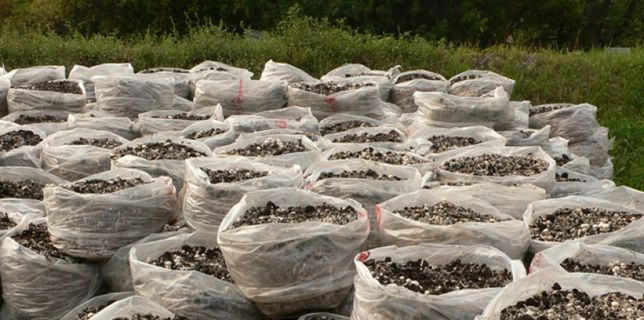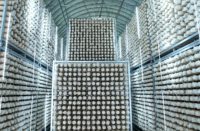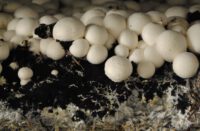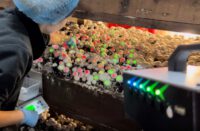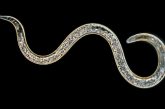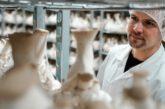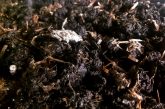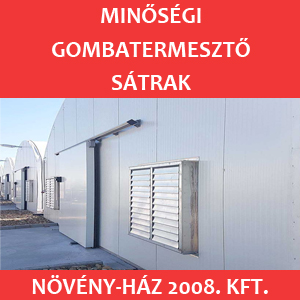In Hungary the amount of spent champignon mushroom substrate currently produced on a yearly basis is approximately 120-130 thousand tons. Only a small part of this is used in private gardens, in different vegetable-growing mediums and on grape and fruit plantations, while a significant part of it ends up in illegal landfills. As a result, no matter how valuable the waste of the mushroom industry may be, it also represents a source of environmental pollution, mostly due to the fact that it leaves most mushroom producing houses in plastic foil bags, resulting in a yearly average of 150-200 tons of polluted polyethylene bags. Another factor that hinders the utilization of spent mushroom substrate is the fact that the EU considers spent mushroom substrate to be waste; however, the reason for the adoption of this law is probably a badly-prepared decision that lacked the thorough prior examination that would support correct decision-making. It is true that there are some mushroom diseases that may be cured through the application of salt, but this method is becoming less and less popular as shelf-based mushroom production systems become increasingly widespread. Some farms use hot steam for their rooms and substrate before release. Furthermore, it is partly due to the use of intensive technology that in many cases only two harvests are possible and, as a result, the growing cycle has become so short that most diseases that affect mushrooms simply do not have time to develop.
Utilization opportunities, examples from abroad
The use of spent champignon substrate has come into focus again in the last few years. Different countries have quite different utilization practices. The disposal of spent substrate has always represented a significant challenge in both Holland and Germany. In 1995 in Spain 16 composting plants established a recycling plant through the creation of a cooperative company. The composting plants pay for and manage the transportation of spent substrate from producer to plant. A total of 90-95 percent of all compost is processed. On the premises of the plant the incoming spent substrate material is first measured, then the bags are emptied and the material is stacked, matured, and finally sold as garden soil. In order to produce the best quality garden soil possible, the plant cooperates with several universities and research institutes.
There are other encouraging and interesting alternatives for substrate use throughout the world. In China, the spent substrate is used to ‘produce’ earthworms and other insects, and the protein thus obtained is later fed to fish and chicken. In Japan, a special extract is made from the spent substrate which is used to increase the hormone production of cucumbers and melons. As far as added value is concerned, the most promising results come from China and India, where spent and long-composted champignon substrate has been tested as a replacement for turf with quite positive outcomes. In India – as this continent-size country lacks areas with turf resources – the spent substrate is matured for a few years, then disinfected and reused as covering material in champignon production.
In the United States the utilization of spent mushroom substrate – or SMS for short – has been researched for some decades. Research findings, collected mostly by Pennsylvania State University, are introduced to producers in a 25-page colour brochure with complete tables for utilization. A special website supports multi-purpose utilization by providing guidance for each plant culture production. In addition to this, short color leaflets also highlight the utilization opportunities for spent mushroom substrate. Results from America have demonstrated a yield increase in the cases of corn, broccoli and tomato following substrate application. Lawn plantation tests have also produced significant findings. The authors emphasize that the stable homogeneous material texture of spent mushroom substrate is an advantage, as well as its high water and nutrient binding properties. Due to its origin, spent mushroom substrate does not contain any weed seeds, unlike animal manure. Its heavy metal content is very low, so its consumption does not represent any hazard to customers.
The method of utilization used by carpet grass producers is also of significant importance. Lawn seed plantations receive a mushroom compost ‘bed’ and, as a result, are easy to separate from the earth after being sold. Moreover, damage to grass roots is significantly reduced. This method is widespread in both Canada and the US.
The Dutch mushroom industry has defined the goal of burning compost. A mushroom production farm has been established in which the spent mushroom substrate is burnt in a burner developed specially for this purpose. Relatively little objective information has been published about this method. The system pre-dries the compost, so gas is necessary for starting the process. The thermal centre ultimately becomes sustainable and it is claimed that enough surplus energy is produced to cover the energy consumption demands of a small mushroom plant. Unfortunately, it must be acknowledged that since the establishment of this plant no similar systems have been built, probably due to the high investment costs.
Hungarian results
In Hungary spent mushroom substrate is transported from large-size mushroom plants to thermal power plants to be burnt. Thermal power plants use the spent mushroom substrate to slow down the incineration process as its moisture content is high: this is the professional justification for the ‘illogical’ process of burning valuable material. The real reason is more materialistic, however. Through this means, thermal power plants fulfil their obligation to engage in the incineration of mixed renewable sources of energy: mushroom compost is continuously available, and plants also receive EU support for this process.
Significantly more environmentally friendly developments have been undertaken by Pilze-Nagy Ltd. as their method of energetically utilizing spent mushroom substrate was designed specifically for this goal. The company’s biogas plant was constructed and is continuously operating in Kecskemét to reuse spent oyster mushroom substrate. At the plant spent oyster mushroom blocks are mixed with poultry manure and then fermented to produce methane, which is later burnt to create electricity. This electricity is used by mushroom-producing plants, and the fermentation liquid is used to maintain soil vitality in arable land areas from which some of the straw required for mushroom production is harvested.
The efforts that are being made by Pilze-Nagy Ltd. to reuse straw substrate and to create a closed carbon circulation system are exceptional. Oyster mushrooms are considered a raw material for production; that is, one more technological step can be integrated into the process of recycling spent oyster mushroom blocks. As the structure and composition of the substrate is much simpler than that of champignon compost, this material can also be used as feed or supplements for some animals (sheep or goats), as long as the problems of managing the high protein content are dealt with in the right way.
In Hungary, research has been carried out in the area of animal feed production using lignocellulose systems pre-treated with mushroom mycelium (e.g. straw or corn stalks); however, the uptake of this so-called myco animal feed has been hindered by the fact that the method could not compete with intensive seed-based and pellet feeds.
Development opportunities, research alternatives
Areas for mining turf in Hungary are being depleted, and are also protected in accordance with nature and water protection regulations, which is essential as these turf layers play an important role in cleaning natural waters. As a result, the mushroom industry relies on turf imports, which increases production costs and decreases the competitiveness of the sector. Thus, it is the responsibility of the gardening sector to develop alternative products that can replace turf, and for accomplishing this goal – that is, creating these products – spent mushroom substrate could be an ideal raw material.
There have already been attempts to produce materials that could replace turf using spent mushroom substrate. However, these efforts usually stopped when supporting research and development finance ran out. Some partial results may provide the necessary basis for restarting such experiments. Without sectorial level cooperation, however, no efficient development will be possible since raw materials should be processed at a central location to provide sufficient amounts of products for such trials. The players in the Hungarian mushroom industry are not cooperating in this area, so the problem can only be managed by actors from outside the sector.
The organic matter content of fertile soils in Hungary and the related fertility levels have been declining continuously for the last 15 years. On the one hand, there is a significant lack of organic manure on a national basis, while on the other, a large amount of spent mushroom substrate – which is considered an environmentally polluting by-product and is treated as such – is available.
Research findings from Hungary show that a 30 t/ha or 60 t/ha dose of spent champignon compost spread did not supply enough nutrients by itself for cabbage production. Experiments show that the 60 t/ha dose even resulted in a slight decrease in product yield compared to the no-treatment option. The reason for this may be the high salt content of mushroom compost. The study also found that mushroom substrate composted for several years did not provide sufficient nitrogen for the development of plants. However, if the level of some nutrients is increased, mushroom compost may be a valuable soil improver and its benefits will not only be observed in the improvement of soil structure, but also in plant yield.
All of the utilization opportunities listed above highlight the value of spent mushroom substrate, which at the moment is not being appropriately taken advantage of in Hungary.
Results of an examination of spent champignon mushroom substrate – Győrfi J.,Maszlavér P., F.-Póczik E.(2004):
| Examined elements | 100% spent substrate (dry matter %) |
| NH4-N: | 0.035 |
| Total N: | 2.89 |
| K: | 2.21 |
| Ca: | 4.84 |
| Mg: | 0.74 |
| Fe: | 0.17 |
| Na: | 0.19 |
| Al: | 0.25 |
| Dry matter content: | 67.70 |
| Salt content: | 14.00 |
| pH: | 6.57 |
The Hungarian research efforts mentioned before also included a complex farming experiment in which spent mushroom substrate was mixed into the soil in different proportions and was also reused on vegetable plantations. The yield of cucumber plants growing in a medium mixed 25/50 percent with spent substrate exceeded the yield of the control culture medium in terms of both quantity and quality. Results show that spent mushroom substrate can successfully be applied in garden farming. If a smaller amount or 50 percent of substrate is mixed into the soil, plants will produce significantly better quality and quantity yields compared to a control medium typical of the usual garden turf mixtures. If plants are grown only in spent substrate compost, it is likely that product quality will be much higher, although yield will probably be lower than with other types of medium.
In conclusion, it can be stated that the most efficient method of substrate reuse is further composting of the spent mushroom substrate and its enrichment with micro and macro elements. The compost produced in this way may serve as a valuable resource for resupplying nutrients to Hungarian land and improving soil structure. In addition to this, it is also worth using it to produce black earth for flowers and garden soil mixtures for new plants or seedlings, both for use in private gardens and larger plant operations.
Author: Csaba Hajdú PhD


